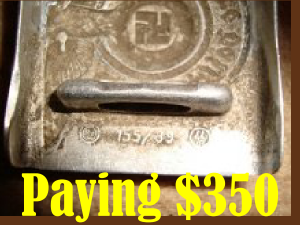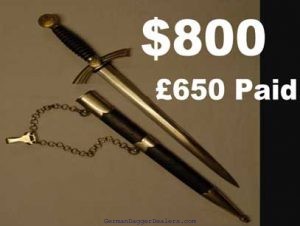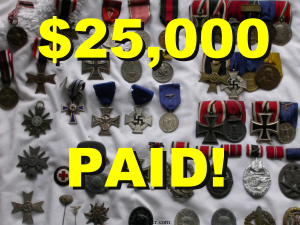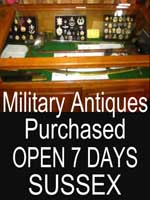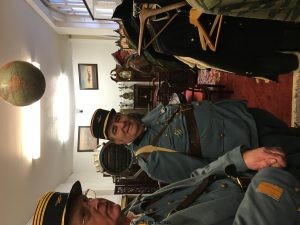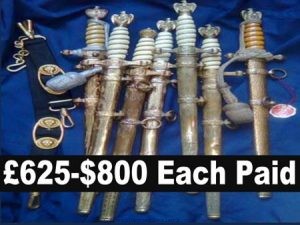Would you like more money for your dagger?congratulations we pay more!
Why Sell To German dagger Dealers.com ?
Firstly we pay your price!
If we cannot pay a better price than you can achieve
elsewhere we will not get your business.
Why are we buying Nazi items ?
We have a large retail
shop
in a busy location
together with an impressive
online presence 14 Websites !
Our store is in it’s self an unofficial
museum enjoyed by thousands of visitors .
All historical artifacts acquired by
German Dagger Dealers.com are for the consumption
of a vetted circle of mature collectors,
ethical investment groups ,museums and historians.
artifacts are sold exclusively to
a carefully vetted buyers
many of whom we have
dealt with for the last ten years .
German dagger dealers.com entirely
distance themselves from those who would supply
Third Reich Symbols to
fuel Neo Nazi ideological.

The $200,000,000 Collection of Nazi WW2 Items
The Englishman who owns the $200,000,000
collection of Nazi Artifacts .
to gain some understanding of the complexities of this most contentious area I recommend the following article.
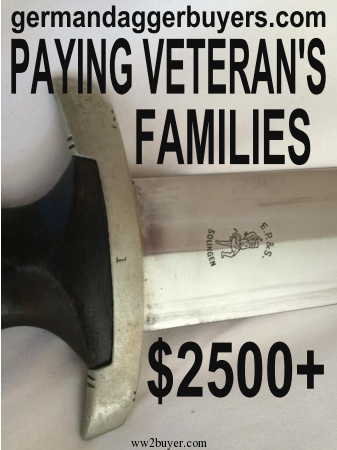
As the crimes of the Nazi regime retreat
further into the past, there seems to be
an increasing desperation in the race to get
hold of mementos of the darkest chapter
of the 20th century.
In the market for Nazi
memorabilia, two out of the three principal
ideologies of the era
— fascism and capitalism —
collide, with the mere financial
value of these objects used to
justify their acquisition, the spiralling
prices trapping collectors in a frantic race for the rare and the covetable
An Englishman
owns the largest collection of Third Reich Militaria
When he was 5 years old, He received an
unusual birthday present from his parents:
a bullet-Damaged Waffen SS helmet,
A lightning bolt transfer on It’s side.
It was a special request.
The next year, at a car auction in Monte Carlo,
he asked his multimillionaire father for
a Mercedes: the G4 that Hitler rode into
the Sudetenland in 1938.
Father refused to buy it and his son
cried all the way home.
At 15, he spent birthday money from
his grandmother on three WWII Jeeps
recovered from the Shetlands,
which he restored himself and sold
for a tidy profit.
He invested the
proceeds in four more vehicles,
together with his very first tank.
The Englishman begged his father
to buy him Hitler’s Mercedies when
he was just six-years-old, and cried
when his father refused. He now owns it.
After leaving school at 16, he went
to work for an engineering firm, and
then for his father’s construction company.
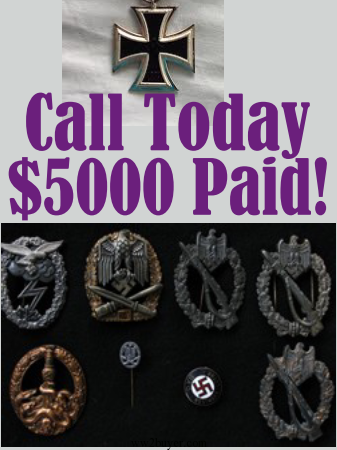
He spent his spare time touring
wind-blasted battle sites in Europe
and North Africa, searching for tank parts
and recovering military vehicles that
he would ship home to restore.
The ruling passion of his life,
though, is what he calls the
— widely regarded as the world’s
largest accumulation of German military
vehicles and Nazi memorabilia.
The collection has largely been
kept in private,
under heavy guard, in a warren of
industrial buildings.
There is no
official record of the value of His
collection, but some estimates place
it at over $160 million.
Since that initial SS helmet,
His life has been shaped by his
obsession for German military memorabilia.
He has travelled the world tracking down
items to add to his collection,
flying into remote airfields, following
up unlikely leads, throwing himself into
hair-raising adventures in the pursuit
of historic objects.
He readily admits that his urge to accumulate
has been monomaniacal,
Often elbowing out a regular social and family life.
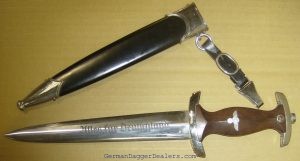
The French theorist Jean Baudrillard once
noted that collecting mania is found
most often in “pre-pubescent boys and
males over the age of 40”; the things we hoard,
he wrote, tend to reveal deeper truths.
Despite the trade of Nazi antiquities being
banned or strictly regulated in many countries,
the market’s annual global turnover is
expected to be in excess of $47 million.
A signed copy of Mein Kampf goes for around
$31,000.
His Father came back with a wife, who he had
first seen from the turret of a tank as he pulled
into her village in Germany.
Father made hundreds of millions in the post-war
building boom, then spent the rest of his
life indulging his zeal for motor cars.
Our Englishman speaks of his late father as
“not just my dad, but also my best friend Despite
being one of seven children,he was the sole
beneficiary of his father’s will. He no longer
speaks to his siblings.
It is hard to say how much the echoes of
atrocity that resonate from Nazi Artifacts
compel the enthusiasts who haggle for and
hawk them. The trade in Third Reich antiquities
is either banned or strictly regulated in Germany,
France, Austria, Israel and Hungary.
Still, the business flourishes, with burgeoning
online sales and increasing interest from
buyers in Russia, America and the Middle East;
The Englishmans biggest rival is a mysterious,
unnamed Russian buyer.
A Holocaust denier runs one of the
most-visited Nazi antiquities websites,
and is currently verifying charred bones
said to be those of Hitler and Eva Braun
Naturally, exact figures are hard to come by,
but the market’s annual global turnover is
estimated to be in excess of $47 million.
One of the most-visited websites is run
by Holocaust denier David Irving,
who in 2009 sold Hitler’s walking stick
(which had previously belonged to Friedrich
Nietzsche) for $5,750. Irving has offered strands
of Hitler’s hair for $200,000, and says he is
currently verifying the authenticity
of charred bones said to be those of
Hitler and Eva Braun.
There is also a roaring trade in the
automobiles of the Third Reich — in 2009,
one of Hitler’s Mercedes sold for almost
$7.8 million. A signed copy of Mein Kampf
will set you back $31,000, while in 2011 an
unnamed investor purchased Joseph Mengele’s
South American journals for $473,000.
As the crimes of the Nazi regime
retreat further into the past, there
seems to be an increasing desperation
in the race to get hold of mementos of the
darkest chapter of the 20th century.
In the market for Nazi memorabilia, two out
of the three principal ideologies of the era
— fascism and capitalism — collide,
with the mere financial value of these
objects used to justify their acquisition,
the spiralling prices trapping collectors
in a frantic race for the rare and the covetable.
In Walden, Henry David Thoreau observed
that “the things we own can own us too”;
this is the sense I — that he started off
building a collection, but that very quickly
the collection began building him.
‘I was in the area’
Inside one of the countless rooms where
Our gentleman keeps his artifacts.
He speaks of wanting people to see
his collection, “I’m only one man and
there’s just so much of it.
When I went to Leicestershire near the
end of last year to see the collection,
a visibly tired Our Man met me off the train.
“I want people to see this stuff,” he told me.
“There’s no better way to understand history.
But I’m only one man and there’s just so much of it.”
He had been trying to set his collection in order,
cataloging late into the night, and making
frequent trips to Cornwall, where, at
huge expense, he was restoring the only
remaining Kriegsmarine S-Boat in existence.
Wheatcroft had recently purchased two
more barns and a dozen shipping
containers to house his collection.
The complex of industrial buildings,
stretching across several flat Leicestershire acres,
seemed like a manifestation of his obsession — just as haphazard, as cluttered and as dark.
As we made our way into the first of his warehouses,
He stood back for a moment, as if shocked by
the scale of what he had accumulated.
Many of the tanks before us were little more
than rusting husks, ravaged by the years
they had spent abandoned in the deserts
of North Africa or on the Russian steppes.
They jostled each other in the warehouses,
spewing out to sit in glum convoys around
the complex’s courtyard.
“I want people to see this stuff.
There’s no better way to understand history.”
“Every object in the collection has a story,”
He told me as we made our way under
the turrets of tanks, stepping over
V2 rockets and U-boat torpedoes.
“The story of the war, then subsequent wars,
and finally the story of the recovery and
restoration. All that history is there in
the machine today.”
We stood beside the muscular bulk of a
Panzer IV tank, patched with rust and
freckled with bullet holes, its tracks
trailing barbed wire.
Wheatcroft scratched at the palimpsest
of paintwork to reveal layers of color
beneath: its current livery, the duck-egg
blue of the Christian Phalangists from
the Lebanese civil war, flaking away to the
green of the Czech army who used the
vehicles in the 1960s and 70s, and
finally the original German taupe.
The tank was abandoned in the
Sinai desert until The Enthusiast arrived
on one of his regular shopping trips
to the region and shipped it
home to Leicestershire.
This Englishman owns
a fleet of 88 tanks
— more than the Danish and Belgian
armies combined. The majority of
the tanks are German, and Wheatcroft
recently acted as an adviser to David Ayer,
the director of “Fury” (in which Brad Pitt
played the commander of a German-based
US Sherman tank in the final days of the war)
. “They still got a lot of things wrong,”
he told me. “I was sitting in the cinema
with my daughter saying, ‘That wouldn’t
have happened’ and ‘That isn’t right.’
Good film, though.”
Modal Trigger
A Panzer (or Panzerkampfwagen) III,
used by the German forces during World War II.
Our Collector owns a Panzer IV tank,
as well as a fleet of 88 other tanks.
Around the tanks sat a number of
strange hybrid vehicles with caterpillar
tracks at the back, truck wheels
at the front.The enthusiast explained
to me that these were half-tracks,
deliberately designed by the Nazis
so as not to flout the terms of the
Treaty of Versailles, which stipulated
that the Germans could not build tanks.
He owns more of these than anyone
else in the world, as well as having
the largest collection of Kettenkrads,
which are half-motorbike, half-tank,
and were built to be dropped out of gliders.
A Kettenkrad, an army motorcycle that
the Germans built during World War II
after the terms in the Treaty of Versailles
stipulated the Germans could not build tanks.
He owns more of these half-motorbike,
half-tank vehicles, than anyone in the world.Photo: AP
“They just look very cool,”
he said with a grin.
Alongside the machines’ stories of
wartime escapades and the sometimes
dangerous lengths that He had gone
to in order to secure them were the
dazzling facts of their value. “The Panzer
IV cost me $25,000. I’ve been offered two
and a half million for it now. It’s the
same with the half-tracks.
They regularly go for over a million each.
Even the Kettenkrads, which I’ve picked
up for as little as $1,500, go for $235,000.”
I tried to work out the total value of the
machines around me, and gave up
somewhere north of $78 million.
He had made himself a fortune,
almost without realizing it.
“Everyone just assumes that I’ve inherited
a race track and I’m a spoilt rich kid who
wants to indulge in these toys,” he told me,
a defensive edge to his voice.
“It’s not like that at all. My dad supported me,
but only when I could prove that
the collection would work financially.
And as a collector, you never have
any spare money lying around.
Everything is tied up in the collection.”
Leaning against the wall of one of
the warehouses, I spotted a dark wooden door,
heavy iron bolts on one side and a
Judas window in the centre.
The collector saw me looking at it.
“That’s the door to Hitler’s cell in Landsberg.
Where he wrote ‘Mein Kampf.’ I was in the area.”
A lot of Wheatcroft’s stories start like
this — he seems to have a genius
for proximity. “I found out that the
prison was being pulled down.
I drove there, parked up and watched
the demolition. At lunch I followed
the builders to the pub and bought
them a round. I did it three days in a
row and by the end of it, I drove off
with the door, some bricks and
the iron bars from his cell.”
It was the first time he had mentioned
Hitler by name. We paused for a moment
by the dark door with its black bars,
then moved on.
Hermann Göring and Hitler in 1944.
Our Man owns a signed photograph
of the Nazi duo and says,
“I think I could give up everything else,
the cars, the tanks, the guns,
as long as I could still have Adolf
and Hermann.”Photo:
Sometimes the stories of search and
recovery were far more interesting
than the objects themselves.
Near the door sat a trio of rusty wine racks.
“They were Hitler’s,” he said,
laying a proprietary hand upon
the nearest one.
“We pulled them out of the ruins
of the Berghof [Hitler’s home in
Berchtesgaden] in May 1989.
The whole place was dynamited in ’52,
but my friend Adrian and I climbed
through the ruins of the garage and
down through air vents to get in.
You can still walk through all
of the underground levels.
We made our way by torchlight
through laundry rooms,
central heating service areas.
Then a bowling alley with big
signs for Coke all over it.
Hitler loved to drink Coke.
We brought back these wine racks.”
The cell in Landsberg prison
where Hitler was incarcerated in 1923.
When Our Student Of engineering heard the prison was
being pulled down, he drove to watch
the demolition and collected the door,
bricks and the iron bars from Hitler’s cell
.Photo: Getty Images
Later, among engine parts and ironwork,
I came across a massive bust of Hitler,
sitting on the floor next to a condom
vending machine (“I collect pub memorabilia, too,”
He explained). “I have the largest
collection of Hitler heads in the world,”
he said, a refrain that returned again and again.
“This one came from a ruined castle in Austria.
I bought it from the town council.”
“Things have the longest memories of all,”
says the introduction to a recent essay
by Teju Cole, “beneath their stillness,
they are alive with the terrors they have
witnessed.” This is what you feel in
the presence of the Collection —
a sense of great proximity to history,
to horror, an uncanny feeling that
the objects know more than they are letting on.
Wheatcroft’s home sits behind high
walls and heavy gates. There is a pond,
its surface stirred by the fingers
of a willow tree. A spiky black mine bobs
along one edge. The house is huge
and modern and somehow without logic,
as if wings and extensions have been
appended to the main structure willy-nilly.
When I visited, it was late afternoon,
a winter moon climbing the sky.
Behind the house, apple trees hung
heavy with fruit. A Krupp submarine
cannon stood sentry outside
the back door.
One of the outer walls was set with
wide maroon half-moons of iron work,
inlaid with obscure runic symbols.
“They were from the top of the officers’
gates to Buchenwald, The Collector Continued told
in an offhand manner. “I’ve got replica
gates to Auschwitz — Arbeit Macht Frei
— over there.” He gestured into the gloaming.
I had first heard about Our Collector
from my aunt Gay, who, as a rather
half-hearted expat estate agent,
sold him a rambling chateau near Limoges.
They subsequently enjoyed (or endured)
a brief, doomed love affair.
Despite the inevitable break-up,
my father kept in touch and, several years ago
, was invited to his home. After a drink
in the pub-cum-officers’ mess that
Wheatcroft has built adjacent to his
dining room, my dad was shown
to the guest apartment.
“It was remarkable,” he said, mostly
for the furniture. “That night, my
dad slept in Hermann Göring’s
favorite bed, from Carinhall hunting
lodge, made of walnut wood and
carved with a constellation of
swastikas. There were glassy
eyed deer heads and tusky boars
on the walls, wolf-skin rugs on
the floor. My father was a little spooked,
but mostly intrigued. In an email
soon after, he described the collector
to me as “absurdly decent, almost
unnaturally friendly.”
Darkness had fallen as we stepped
into the immense, two-story barn
conversion behind his home. It was
the largest of the network of buildings
surrounding the house, and wore a fresh
coat of paint and shiny new locks on the doors.
As we walked inside, The Englishman
turned to me with a thin smile,
and I could tell that he was excited.
“I have to have strict rules in my life,”
he said, “I don’t show many people the collection,
because not many people can understand the
motives behind it, people don’t
understand my values.”
The walls where our chap houses
his collection are covered with signs,
iron swastikas, Hitler’s sketches,
and posters that read
“Ein Volk, Ein Reich, Ein Führer.”


